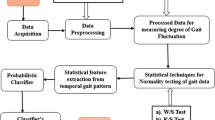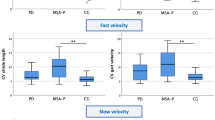Abstract
Gait variability reflects important information for the maintenance of human beings’ health. For pathological populations, changes in gait variability signal the presence of abnormal motor control strategies. Quantitative analysis of the altered gait variability in patients with amyotrophic lateral sclerosis (ALS) will be helpful for either diagnosing or monitoring pathological progression of the disease. Thus, we applied Teager energy operator, an energy measure that can highlight the deviations from moment to moment of a time series, to produce an instantaneous energy time series. Then, two important features were extracted to assess the variability of the new time series. First, the standard deviation statistics were used to measure the magnitude of the variability. Second, to quantify the temporal structural characteristics of the variability, the permutation entropy was applied as a tool from the nonlinear dynamics. In the classification experiments, the two proposed features were input to the support vector machine classifier, and the dataset consists of 12 ALS patients and 16 healthy control subjects. The experimental results showed that an area of 0.9643 under the receiver operating characteristic curve was achieved, and the classification accuracy evaluated by leave-one-out cross-validation method could reach 92.86 %.






Similar content being viewed by others
References
Abdullah AR, Abidullah N, Shamsudin N, Ahmad N, Jopri M (2014) Power quality signals classification system using time–frequency distribution. Appl Mech Mater 494:1889–1894
Abed M, Belouchrani A, Cheriet M, Boashash B (2012) Time–frequency distributions based on compact support kernels: properties and performance evaluation. IEEE Trans Signal Process 60(6):2814–2827
AlThobiani F, Ball A (2014) An approach to fault diagnosis of reciprocating compressor valves using Teager-Kaiser energy operator and deep belief networks. Expert Syst Appl 41(9):4113–4122
Aziz W, Arif M (2006) Complexity analysis of stride interval time series by threshold dependent symbolic entropy. Eur J Appl Physiol 98(1):30–40
Bandt C, Pompe B (2002) Permutation entropy: a natural complexity measure for time series. Phys Rev Lett 88(17):174102
Begg R, Kamruzzaman J (2005) A machine learning approach for automated recognition of movement patterns using basic, kinetic and kinematic gait data. J Biomech 38(3):401–408
Cho SH, Park JM, Kwon OY (2004) Gender differences in three dimensional gait analysis data from 98 healthy Korean adults. Clin Biomech 19(2):145–152
Costa M, Peng C-K, Goldberger AL, Hausdorff JM (2003) Multiscale entropy analysis of human gait dynamics. Phys A 330(1):53–60
Daliri MR (2012) Automatic diagnosis of neuro-degenerative diseases using gait dynamics. Measurement 45(7):1729–1734
Dingwell JB, Cusumano JP (2000) Nonlinear time series analysis of normal and pathological human walking. Chaos Interdiscip J Nonlinear Sci 10(4):848–863
Dong S, Azemi G, Boashash B (2014) Improved characterization of HRV signals based on instantaneous frequency features estimated from quadratic time–frequency distributions with data-adapted kernels. Biomed Signal Process 10:153–165
Dutta S, Chatterjee A, Munshi S (2009) An automated hierarchical gait pattern identification tool employing cross-correlation-based feature extraction and recurrent neural network based classification. Expert Syst 26(2):202–217
Ferlazzo E, Mammone N, Cianci V, Gasparini S, Gambardella A, Labate A, Latella MA, Sofia V, Elia M, Morabito FC (2014) Permutation entropy of scalp EEG: a tool to investigate epilepsies: suggestions from absence epilepsies. Clin Neurophysiol 125(1):13–20
Goldfarb B, Simon S (1984) Gait patterns in patients with amyotrophic lateral sclerosis. Arch Phys Med Rehabil 65(2):61–65
Harbourne RT, Stergiou N (2009) Movement variability and the use of nonlinear tools: principles to guide physical therapist practice. Phys Ther 89(3):267–282
Hausdorff JM, Ladin Z, Wei JY (1995) Footswitch system for measurement of the temporal parameters of gait. J Biomech 28(3):347–351
Hausdorff JM, Peng C, Ladin Z, Wei JY, Goldberger AL (1995) Is walking a random walk? Evidence for long-range correlations in stride interval of human gait. J Appl Physiol 78(1):349–358
Hausdorff JM, Purdon PL, Peng C, Ladin Z, Wei JY, Goldberger AL (1996) Fractal dynamics of human gait: stability of long-range correlations in stride interval fluctuations. J Appl Physiol 80(5):1448–1457
Hausdorff JM, Lertratanakul A, Cudkowicz ME, Peterson AL, Kaliton D, Goldberger AL (2000) Dynamic markers of altered gait rhythm in amyotrophic lateral sclerosis. J Appl Physiol 88(6):2045–2053
He Q (2013) Time–frequency manifold for nonlinear feature extraction in machinery fault diagnosis. Mech Syst Signal Process 35(1):200–218
Hussain ZM, Boashash B (2002) Adaptive instantaneous frequency estimation of multicomponent FM signals using quadratic time–frequency distributions. IEEE Trans Signal Process 50(8):1866–1876
Kaiser JF (1990) On a simple algorithm to calculate the ‘energy’ of a signal. Paper presented at the international conference on acoustics, speech, and signal processing, New Mexico, pp 381–384
Kaiser JF (1993) Some useful properties of Teager’s energy operators. Paper presented at the IEEE international conference on acoustics, speech, and signal processing, Minnesota, pp 149–152
Kamath C (2012) A new approach to detect congestive heart failure using Teager energy nonlinear scatter plot of R–R interval series. Med Eng Phys 34(7):841–848
Kang HG, Dingwell JB (2008) Separating the effects of age and walking speed on gait variability. Gait Posture 27(4):572–577
Kim Y, Shim K, Kim M-S, Lee JS (2014) DBCURE-MR: an efficient density-based clustering algorithm for large data using MapReduce. Inf Syst 42:15–35
Lei KF, Lee K-F, Lee M-Y (2014) A flexible PDMS capacitive tactile sensor with adjustable measurement range for plantar pressure measurement. Microsyst Technol 20(7):1351–1358
Liao F, Wang J, He P (2008) Multi-resolution entropy analysis of gait symmetry in neurological degenerative diseases and amyotrophic lateral sclerosis. Med Eng Phys 30(3):299–310
Liu H, Wang J, Lu C (2013) Rolling bearing fault detection based on the Teager energy operator and Elman neural network. Math Probl Eng 2013:1–10
Maragos P, Potamianos A (1995) Higher order differential energy operators. IEEE Signal Process Lett 2(8):152–154
Maragos P, Quatieri T, Kaiser J (1990) Detecting nonlinearities in speech using an energy operator. Paper presented at the Proceedings of IEEE digital signal process workshop, NY, pp 3024–3051
Metz CE, Herman BA, Shen JH (1998) Maximum likelihood estimation of receiver operating characteristic (ROC) curves from continuously-distributed data. Stat Med 17(9):1033–1053
Ramaswamy S, Rastogi R, Shim K (2000) Efficient algorithms for mining outliers from large data sets. Paper presented at the SIGMOD international conference on management of data, Texas, pp 427–438
Subasi A, Yilmaz AS, Tufan K (2011) Detection of generated and measured transient power quality events using Teager energy operator. Energy Convers Manag 52(4):1959–1967
Vapnik V (2013) The nature of statistical learning theory, 2nd edn. Springer Science & Business Media, New York, NY
Wu Y, Krishnan S (2009) Computer-aided analysis of gait rhythm fluctuations in amyotrophic lateral sclerosis. Med Biol Eng Comput 47(11):1165–1171
Wu Y, Shi L (2011) Analysis of altered gait cycle duration in amyotrophic lateral sclerosis based on nonparametric probability density function estimation. Med Eng Phys 33(3):347–355
Xia Y, Gao Q, Ye Q (2015) Classification of gait rhythm signals between patients with neuro-degenerative diseases and normal subjects: experiments with statistical features and different classification models. Biomed Signal Process 18:254–262
Yan R, Liu Y, Gao RX (2012) Permutation entropy: a nonlinear statistical measure for status characterization of rotary machines. Mech Syst Signal Process 29:474–484
Yang M, Zheng H, Wang H, McClean S, Newell D (2012) iGAIT: an interactive accelerometer based gait analysis system. Comput Methods Programs Biomed 108(2):715–723
Zanin M, Zunino L, Rosso OA, Papo D (2012) Permutation entropy and its main biomedical and econophysics applications: a review. Entropy 14(8):1553–1577
Zeng W, Wang C (2015) Classification of neurodegenerative diseases using gait dynamics via deterministic learning. Inf Sci 317:246–258
Zeng M, Yang Y, Zheng J, Cheng J (2015) Normalized complex Teager energy operator demodulation method and its application to fault diagnosis in a rubbing rotor system. Mech Syst Signal Process 50:380–399
Acknowledgments
This work is supported by the Research Funding for Doctor of Anhui University (J10113190021) and is also supported by National Natural Science Foundation of China (NSFC) for Youth (61402004) and NSFC (61370110).
Author information
Authors and Affiliations
Corresponding author
Ethics declarations
Conflict of interest
The authors declare that they have no conflict of interest.
Rights and permissions
About this article
Cite this article
Xia, Y., Gao, Q., Lu, Y. et al. A novel approach for analysis of altered gait variability in amyotrophic lateral sclerosis. Med Biol Eng Comput 54, 1399–1408 (2016). https://doi.org/10.1007/s11517-015-1413-5
Received:
Accepted:
Published:
Issue Date:
DOI: https://doi.org/10.1007/s11517-015-1413-5




